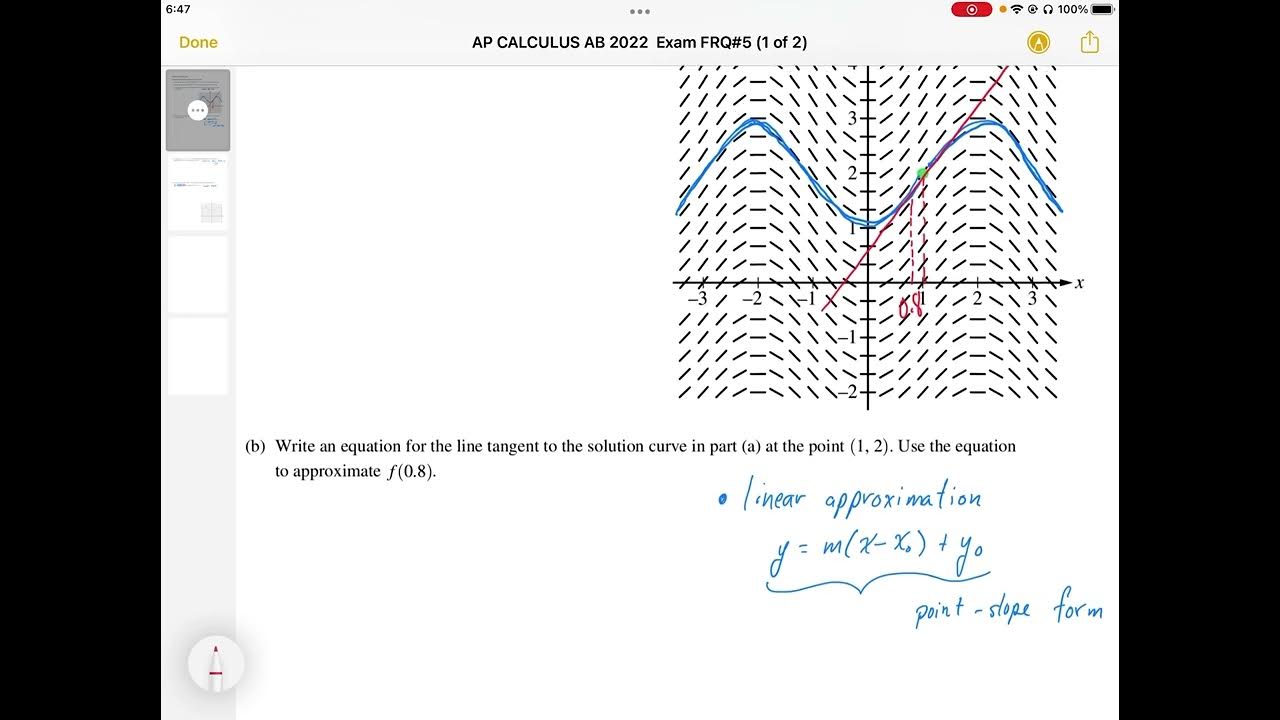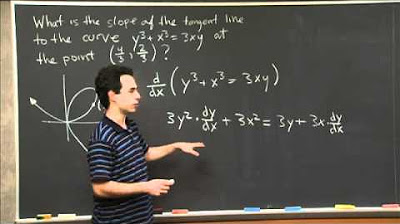Calculus exam question
TLDRThe video script is a step-by-step guide on how to find the equation of a curve passing through a given point by integrating a given function. The example provided involves the function y = 4x^3 + 2, and the process demonstrates how to find its derivative and then integrate it back to find the original function. The constant of integration is explained as an unknown value that can be determined if the point through which the curve passes is known. The final equation derived is y = 3x^2 + 8x - 9, after substituting the x and y coordinates of the given point to solve for the constant.
Takeaways
- 📚 The task is to find the curve or equation of a cave passing through a given point (1, 2).
- 🧮 The given function is y = 4x^3 + 2, and the goal is to find its integral.
- 🔄 To find the integral, focus on the terms with x and ignore the constant term during differentiation.
- 📈 The derivative of y with respect to x (dy/dx) is found to be 12x^2.
- ✅ Integration is the reverse process of differentiation; thus, the integral of 12x^2 is y = 4x^3 + C.
- 🔍 The constant of integration (C) is determined by using the coordinates of the given point (1, 2).
- 📌 The final equation after finding C is y = 3x^2 + 8x - 9, which represents the curve of the cave.
- 👓 When integrating, always include the differential (dx or dy) corresponding to the variable being integrated.
- 📝 Remember to account for the constant term when finding the integral, even if it was zero during differentiation.
- 🎓 Understanding the relationship between derivatives and integrals is crucial for solving calculus problems.
- 📊 The process of solving for the equation of a curve involves both differentiation and integration, and using given points to solve for constants.
Q & A
What is the initial function provided in the example?
-The initial function provided in the example is Y = 4x^3 + 2.
How do you find the derivative of the given function?
-The derivative of the given function is found by multiplying the power of x by the coefficient in front of x, then reducing the power by one. For the constant term, since it does not involve x, its derivative is zero. Therefore, the derivative (dY/dX) of 4x^3 + 2 is 12x^2.
What does the constant 'C' represent in the integration process?
-The constant 'C' represents an arbitrary constant that is added during integration to account for any constant term that was differentiated to zero. It's necessary because the integral could represent a family of curves, each differing by a constant value.
How do you integrate the function 12x^2 to find the original function Y?
-To integrate the function 12x^2, you add one to the power of x and then divide by the new power. Thus, the integral of 12x^2 dx is 4x^3, plus the constant C.
What is meant by the 'gradient function' in the context of this script?
-The 'gradient function' in the context of this script refers to the derivative of a function with respect to x, which represents the slope or rate of change of the function. In this case, it is dY/dX.
How is the constant 'C' determined in the integration examples?
-The constant 'C' is determined by substituting known values of x and y into the integrated function. These known values usually represent a point through which the curve passes. After substituting, you solve for 'C'.
Why do you integrate the function provided as 'the gradient function'?
-You integrate the gradient function to find the original function from which it was derived. This process is the inverse of differentiation and is used to determine the equation of the curve from its slope function.
What is the significance of the point (1, 2) in the context of finding the constant 'C'?
-The point (1, 2) is used as a specific example to solve for the constant 'C'. By substituting x = 1 and y = 2 into the integrated function, you can solve for the value of 'C' to determine the specific equation of the curve passing through that point.
What does the term 'integrating' refer to in the context of this mathematical discussion?
-In this context, 'integrating' refers to the process of finding the antiderivative or integral of a function. It involves finding a function that, when differentiated, yields the given function. This is the opposite operation to differentiation.
How do you apply the integration rule to the function 6X?
-To apply the integration rule to the function 6X, you increase the power of X by one (from 1 to 2) and divide by the new power. Therefore, the integral of 6X dx is 3X^2 plus the constant C.
Outlines
📚 Calculus: Finding the Equation of a Curve
The paragraph introduces a calculus problem where the task is to find the equation of a curve passing through a given point (1,2). The speaker explains the process of finding the integral of a given function, using an example where the function is y = 4x^3 + 2. The explanation includes the steps to find the derivative (gradient function) and then integrating it back to find the original function, emphasizing the importance of handling constants during these processes.
🤔 Understanding Constants in Integration
This section delves into the concept of constants in calculus, explaining why a constant 'c' is included when integrating a function. The speaker clarifies that the constant represents an unknown value that can only be determined if a specific point on the curve is known. The process of solving for 'c' using given coordinates is demonstrated, reinforcing the concept of integrating a gradient function and the importance of understanding the role of 'dx' in integration.
🎓 Solving a Calculus Exam Question
The final paragraph wraps up the calculus problem, showing the complete solution after finding the value of the constant 'c'. The speaker provides the final equation of the curve, y = 3x^2 + 8x - 9, and encourages viewers to apply these concepts in their calculus exams. The video ends with a call to action for viewers to share the video, subscribe to the YouTube channel, and follow on social media.
Mindmap
Keywords
💡Integral
💡Derivative
💡Gradient Function
💡Constant
💡Integration
💡Coordinate
💡Arbitrary Number
💡Equation of a Curve
💡Gradient
💡Substitution
Highlights
The task is to find the curve or equation of a cave passing through a given point (1,2).
The given function is Y = 4x^3 + 2, which is used to find the integral.
To find the derivative, focus on terms with the variable x and ignore constants.
The derivative found is Y' = 12x^2, which represents the gradient function.
Integration is the opposite process of differentiation.
The integrated function is Y = 4x^3 + C, where C is an arbitrary constant.
To find the specific value of C, use the coordinates of the given point (1,2).
By substituting the point into the equation, C is found to be -9.
The final equation of the cave is Y = 3x^2 + 8x - 9.
Understanding the concept of gradient function is crucial for solving this problem.
The process of finding the derivative and integral is demonstrated step by step.
The importance of constants in differentiation and integration is explained.
The method of solving for a specific constant by using given coordinates is illustrated.
The video provides a clear and detailed walkthrough of a calculus problem.
The solution to the problem is presented in a logical and structured manner.
The video encourages viewers to engage with the content by asking questions.
The video concludes with a call to action for viewers to share, subscribe, and follow the channel.
Transcripts
Browse More Related Video

Equation of a tangent line [IB Maths AI SL/HL]

2022 AP Calculus AB Free Response #5

AP CALCULUS AB 2022 Exam Full Solution FRQ#5(a,b)

The derivative of f(x)=x^2 for any x | Taking derivatives | Differential Calculus | Khan Academy

Equation of a normal line [IB Maths AI SL/HL]

Implicit Differentiation | MIT 18.01SC Single Variable Calculus, Fall 2010
5.0 / 5 (0 votes)
Thanks for rating: